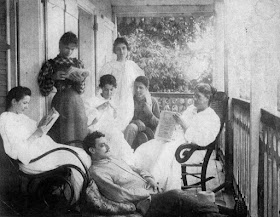When I was a senior in High School I chanced upon a movie
that changed my life. Das Boot was a movie about the exploits of a WWII
German U-boat during the infamous Battles of the Atlantic. Something about the
movie fascinated me. Perhaps it was the cramped conditions on board the
submarine, perhaps it was the maritime setting, perhaps it was the agonizing
suspense. I think the main reason was Jürgen Prochnow, a wonderful actor who
played the ship’s Kapitänleutnant and soon became an international star. I
wasn't alone in these adventures, however. I was joined by my best friend and
partner-in-crime, Beth Nagle, who was just as intrigued by the adventures of
these hardy sailors as I was.
Seeing Jürgen’s picture it’s not hard to imagine why an
18 year old girl would have preferred to spend her days in his company rather
than in Trigonometry or Chemistry. But it was the images of those sailors in
those cramped conditions that really fired my imagination.
About 25 years later all those afternoons in darkened
movie theaters became the engine that drove my first novel, Transfer Day. The
idea that a German U-boat officer could become a sympathetic character was very
intriguing, and I wanted to make it work. First I had to learn what
characteristics these hardy men of the sea possessed.
To understand what it was like to live and fight under
these conditions I dove into the study of U-boats, reading such classics as
“Iron Coffins” and “Steel Boats, Iron Hearts” as well as books about the War of
the Atlantic and accounts of sinkings on websites like uboat.net. It was on
this website that I made the acquaintance of my research partner, Robert
Derencin, a Croatian naval veteran who is one of Europe’s leading U-boat
experts. It was a partnership that grew into a friendship that lasted until
this day. When I told Robert what I wanted to accomplish, namely, to write a
book about a German U-boat officer who deserts his ship in the middle of war
and escapes to the Caribbean, he provided all sorts of scenarios that made the
book possible.
In the end, I believe my character, Erich Seibold, fits the image of a hardy
U-boat officer whose personal ethos prohibits him from sinking passenger ships.
This is the engine that drives my novel forward and puts him in even greater
danger when he escapes to a neutral Danish island only to find out that soon it
will be transferred to the Americans and he will be behind enemy lines.
 |
Kptlt. Otto Weddigen (1880 - 1915)
One of the most infamous U-boat captains of the Great War. |
Perhaps the one scene in the movie that moved me more
than any other was when the U-boat sailors sang the WWI song “It’s a long way
to Tipperary”. That song, more than anything else, symbolized the war for both
sides of the conflict, and I made sure to include it in my novel.
If you
are a writer, what are some of the strangest sources of inspiration you've ever
had? Did they inspire you to write an entire novel? Or did they take you on a
completely different direction?
Transfer Day: When the whole world is at war not even an island is safe.






















